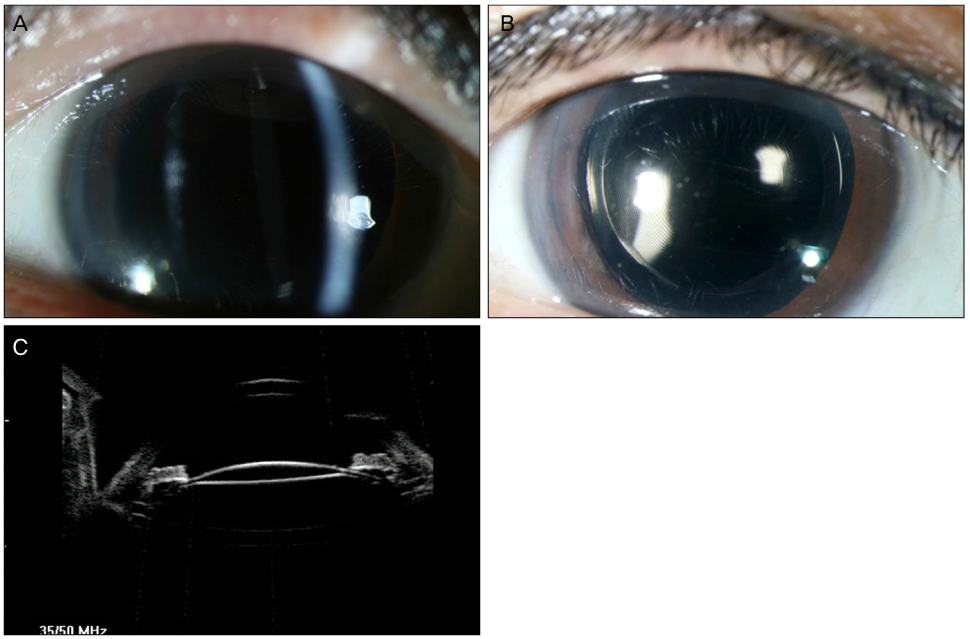J Korean Ophthalmol Soc.
2012 Mar;53(3):396-402.
Visual and Optical Functions after Diffractive Multifocal Intraocular Lens
- Affiliations
-
- 1Raphael Eye Institute, Goyang, Korea. zenith716@hanmail.net
- 2Saevit Eye Hospital, Goyang, Korea.
Abstract
- PURPOSE
To evaluate near, intermediate, and distant vision, optical quality, and patient satisfaction with Acri.LISA aspheric diffractive multifocal IOL.
METHODS
Forty eyes of 20 patients received phacoemulsification and implantation of Acri.LISA IOL. Visual acuity was measured postoperatively at 1 week, 1 month, and 6 months. Contrast sensitivity, wavefront aberration, and visual function via questionnaire were measured at postoperative 1 month.
RESULTS
Uncorrected near, intermediate, and distanct visual acuity at 1 month were 0.09 +/- 0.14, 0.29 +/- 0.17 and 0.11 +/- 0.12, respectively. At 6 months, similar visual acuity results were measured. Total and higher-order wavefront aberration values were 0.66 +/- 0.29 and 0.24 +/- 0.08, respectively. Photopic contrast sensitivity at 1.5, 3, 6, 12, and 18 cycles/degree were 1.38 +/- 0.32, 1.73 +/- 0.24, 1.75 +/- 0.21, 1.33 +/- 0.18, and 0.77 +/- 23, respectively, and mesopic contrast sensitivity values were 1.37 +/- 0.27, 1.72 +/- 0.16, 1.63 +/- 0.14, 1.01 +/- 0.19, and 0.50 +/- 0.22. Total subjective visual function score was 3,127 +/- 354, near work was 244 +/- 36, distance work was 256 +/- 21, and night driving was 221 +/- 42.
CONCLUSIONS
The Acri.LISA 366D multifocal IOL can be effective for improving patient satisfaction after cataract surgery as well as for presbyopia correction.
MeSH Terms
Figure
Reference
-
1. Cezón Prieto J, Bautista MJ. Visual outcomes after implantation of a refractive multifocal intraocular lens with a +3.00 D addition. J Cataract Refract Surg. 2010. 36:1508–1516.2. Wang J, Wu X, Zhang J. Imaging properties of Fresnel zone plate-like surface plasmon polariton launching lenses. Opt Express. 2010. 18:6686–6692.3. Montés-Micó R, España E, Bueno I, et al. Visual performance with multifocal intraocular lenses: mesopic contrast sensitivity under distance and near conditions. Ophthalmology. 2004. 111:85–96.4. Alfonso JF, Puchades C, Fernández-Vega L, et al. Visual acuity comparison of 2 models of bifocal aspheric intraocular lenses. J Cataract Refract Surg. 2009. 35:672–676.5. Montés-Micó R, Alió JL. Distance and near contrast sensitivity function after multifocal intraocular lens implantation. J Cataract Refract Surg. 2003. 29:703–711.6. Alió JL, Elkady B, Ortiz D, Bernabeu G. Clinical outcomes and intraocular optical quality of a diffractive multifocal intraocular lens with asymmetrical light distribution. J Cataract Refract Surg. 2008. 34:942–948.7. Heo JW, Yoon HS, Shin JP, et al. A validation and reliability study of the Korean version of National Eye Institute visual function questionnaire 25. J Korean Ophthalmol Soc. 2010. 51:1354–1367.8. Apple DJ, Sims J. Harold Ridley and the invention of the intraocular lens. Surv Ophthalmol. 1996. 40:279–292.9. Alió JL, Plaza-Puche AB, Piñero DP, et al. Optical analysis, reading performance, and quality-of-life evaluation after implantation of a diffractive multifocal intraocular lens. J Cataract Refract Surg. 2011. 37:27–37.10. Castillo-Gómez A, Carmona-González D, Martínez-de-la-Casa JM, et al. Evaluation of image quality after implantation of 2 diffractive multifocal intraocular lens models. J Cataract Refract Surg. 2009. 35:1244–1250.11. Fernandez-Vega L, Madrid-Costa D, Alfonso JF, et al. Bilateral implantation of the Acri.LISA bifocal intraocular lens in myopic eyes. Eur J Ophthalmol. 2010. 20:83–89.12. Alfonso JF, Puchades C, Fernández-Vega L, et al. Contrast sensitivity comparison between AcrySof ReSTOR and Acri.LISA aspheric intraocular lenses. J Refract Surg. 2010. 26:471–477.13. Chang MW, Eom YS, Kang SY, Kim KH, et al. Clinical outcome of diffractive multifocal aspheric intraocular lens. J Korean Ophthalmol Soc. 2009. 50:529–536.14. Yoon JU, Chung JL, Hong JP, et al. Comparison of wavefront analysis and visual function between monofocal and multifocal aspheric intraocular lenses. J Korean Ophthalmol Soc. 2009. 50:195–201.15. Lee HS, Park SH, Kim MS. Clinical results and some problems of multifocal apodized diffractive intraocular lens implantation. J Korean Ophthalmol Soc. 2008. 49:1235–1241.16. Mangione CM, Lee PP, Gutierrez PR, et al. Development of the 25-item National Eye Institute Visual Function Questionnaire. Arch Ophthalmol. 2001. 119:1050–1058.17. Stelmack JA, Stelmack TR, Massof RW. Measuring low-vision rehabilitation outcomes with the NEI VFQ-25. Invest Ophthalmol Vis Sci. 2002. 43:2859–2868.18. Alió JL, Plaza-Puche AB, Piñero DP, et al. Quality of life evaluation after implantation of 2 multifocal intraocular lens models and a monofocal model. J Cataract Refract Surg. 2011. 37:638–648.19. Goes FJ. Refractive lens exchange with the diffractive multifocal Tecnis ZM900 intraocular lens. J Refract Surg. 2008. 24:243–250.20. Choi J, Schwiegerling J. Optical performance measurement and night driving simulation of ReSTOR, ReZoom, and Tecnis multifocal intraocular lenses in a model eye. J Refract Surg. 2008. 24:218–222.
- Full Text Links
- Actions
-
Cited
- CITED
-
- Close
- Share
- Similar articles
-
- Pseudoaccomodation in Pseudophakic Eyes with 3M Multifocal Intraocular Lens
- Clinical Results and Optical Quality of Diffractive Multifocal Intraocular Lens
- Comparison of the Visual Outcomes after Cataract Surgery with Implantation of a Bifocal and Trifocal Diffractive Intraocular Lens
- Clinical Outcomes of Diffractive Multifocal Toric Intraocular Lens Implantation
- Clinical Results of 3M Multifocal Intraocular Lens





